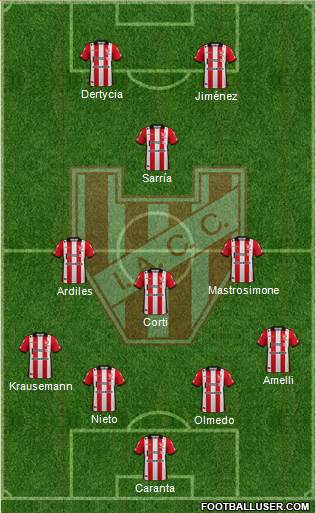|
It is currently Thu Oct 23, 2025 5:35 am |
|
All times are UTC |
|
|
Page 1 of 1 |
[ 3 posts ] |
| Print view | Previous topic | Next topic |
Instituto A.C.C. All Stars
| Author | Message |
|---|---|
|
Joined: Fri Apr 02, 2021 11:21 pm Posts: 370 Location: Buenos Aires, Argentina |
Instituto Atlético Central Córdoba All Stars   COACH:  Héctor RIVOIRA Héctor RIVOIRA GOALKEEPERS:  Ramón ÁLVAREZ Ramón ÁLVAREZ Mauricio CARANTA Mauricio CARANTADEFENDERS:  Eduardo ANELLI Eduardo ANELLI Roberto BRUNETTO Roberto BRUNETTO Mario CORTEZ Mario CORTEZ Raúl DAMIANI Raúl DAMIANI Roberto KRAUSEMANN Roberto KRAUSEMANN Enrique NIETO Enrique NIETO Miguel OLMEDO Miguel OLMEDOMIDFIELDERS:  Osvaldo ARDILES Osvaldo ARDILES Alberto BELTRÁN Alberto BELTRÁN Ernesto CORTI Ernesto CORTI Víctor HEREDIA Víctor HEREDIA Salvador MASTROSIMONE Salvador MASTROSIMONE Fernando OLIVA Fernando OLIVA Claudio SARRÍA Claudio SARRÍAFORWARDS:  Raúl De La Cruz CHAPARRO Raúl De La Cruz CHAPARRO Hugo CURIONI Hugo CURIONI Oscar DERTYCIA Oscar DERTYCIA Germán ESQUIVEL Germán ESQUIVEL Daniel JIMÉNEZ Daniel JIMÉNEZ Mario Alberto KEMPES Mario Alberto KEMPES Diego KLIMOWICZ Diego KLIMOWICZ__________________________________________________ RESERVES: GOALKEEPERS:  Ezequiel BALVERDI Ezequiel BALVERDI Carlos MUNUTTI Carlos MUNUTTI Jorge PERRIOT Jorge PERRIOT Hugo TRUCCHIA Hugo TRUCCHIADEFENDERS:  Ángel ARATA Ángel ARATA Federico BESSONE Federico BESSONE Francisco BUTELER Francisco BUTELER Fernando CLEMENTZ Fernando CLEMENTZ Ramón GALARZA Ramón GALARZA José GUERRERO José GUERRERO Américo GUTIÉRREZ Américo GUTIÉRREZ Julio MOREYRA Julio MOREYRA Luis OROPEL Luis OROPEL Félix PACHECO Félix PACHECO Leonel PILIPAUSKAS Leonel PILIPAUSKAS Julio ZAPATA Julio ZAPATAMIDFIELDERS:  Mario ACUÑA Mario ACUÑA Washington ARECO Washington ARECO Ramón Arsenio BENÍTEZ Ramón Arsenio BENÍTEZ Sergio BONFIGLI Sergio BONFIGLI Hernán BUJÁN Hernán BUJÁN Alejandro FAURLÍN Alejandro FAURLÍN Sergio GONZÁLEZ Sergio GONZÁLEZ Raúl MALDONADO Raúl MALDONADO Juan José MEZA Juan José MEZA Santiago RAYMONDA Santiago RAYMONDA Ricardo RENTERA Ricardo RENTERA Silvio RISIO Silvio RISIO Rodolfo RODRÍGUEZ Rodolfo RODRÍGUEZFORWARDS:  Mauro AMATO Mauro AMATO Julio BENAVIDES Julio BENAVIDES Hernán BOYERO Hernán BOYERO Fernando CASTRO Fernando CASTRO José Luis CEBALLOS José Luis CEBALLOS Ariel COZZONI Ariel COZZONI Paulo DYBALA Paulo DYBALA Mario GHIRARDO Mario GHIRARDO Carlos LOVERA Carlos LOVERA Osvaldo MÁRQUEZ Osvaldo MÁRQUEZ Silvio ROMERO Silvio ROMERO José Luis SALDAÑO José Luis SALDAÑO Miguel SALDAÑO Miguel SALDAÑOTHE BEST EVER XI  GK CARANTA CB NIETO CB OLMEDO © RB ANELLI LB KRAUSEMANN DMF CORTI CMF ARDILES CMF MASTROSIMONE AMF SARRÍA CF DERTYCIA CF JIMÉNEZ Captain: Miguel Olmedo | Enrique Nieto Short free kick: Claudio Sarría | Salvador Mastrosimone Long free kick: Salvador Mastrosimone | Osvaldo Ardiles Free kick 2: Osvaldo Ardiles Right corner: Claudio Sarría Left corner: Claudio Sarría Penalty: Daniel Jiménez INFO: Spoiler: show Last edited by Nacho1605 on Mon Dec 09, 2024 3:35 am, edited 3 times in total. |
| Mon May 20, 2024 5:28 pm |
|
|
Joined: Wed Jun 26, 2013 9:38 pm Posts: 2561 |
Curioni, Kempes and Ardiles in first team here? Those guys all played few games for the club at the beginning of their career, there is no way that there are no other players with better careers at the club. I understand Dybala in reserves but that should the maximum for the other guys as well..
|
| Mon May 20, 2024 5:43 pm |
|
|
Joined: Fri Apr 02, 2021 11:21 pm Posts: 370 Location: Buenos Aires, Argentina |
gurkenjoe93 wrote: Curioni, Kempes and Ardiles in first team here? Those guys all played few games for the club at the beginning of their career, there is no way that there are no other players with better careers at the club. I understand Dybala in reserves but that should the maximum for the other guys as well.. Instituto began playing in the National Championships in 1973; before that, they played all their matches in the Cordoba League. Hugo Curioni played between 1968 and 1970 and was very important in winning the 1969 Torneo Selección of the Cordoba League. After succeeding at Boca and in France, he returned to the club in 1981 to play in the AFA tournaments. Ardiles and Kempes were the best players for Instituto in the early '70s, helping the team win the Cordoba League for the ninth (and last) time in 1972 and playing in the National Tournament for the first time in the club's history. The matches and goals of the pre-AFA players are not well recorded, so many of these players have officially low numbers compared to their actual achievements. For example, Curioni scored 47 goals in 68 matches accounted for by the Cordoba League; Diego Klimowicz, the fifth-highest scorer in AFA tournaments, scored 45 goals in 95 matches and no one would diminish his legend status for the club. The history of clubs from the interior of the country is very different from that of clubs from the Buenos Aires metropolitan area, so different criteria must be used when forming these types of teams. It is very difficult to overlook players of the caliber of Kempes, Curioni, or Ardiles because "they played when they were young at the club," knowing that when they played, Argentine football was entirely different. The first National Tournament was played in 1967, thirty-seven years after the professionalization of Argentine football. Before that, teams from the interior (also called "indirectly affiliated teams") only played in their regional leagues, and a title back then was worth exactly the same as a First Division title for the clubs from Buenos Aires or Rosario. Instituto (just like their provincial peers Talleres and Belgrano) experienced this situation. |
| Mon May 20, 2024 6:12 pm |
|
|
|
Page 1 of 1 |
[ 3 posts ] |
|
All times are UTC |
Who is online |
Users browsing this forum: No registered users and 2 guests |
| You cannot post new topics in this forum You cannot reply to topics in this forum You cannot edit your posts in this forum You cannot delete your posts in this forum You cannot post attachments in this forum |